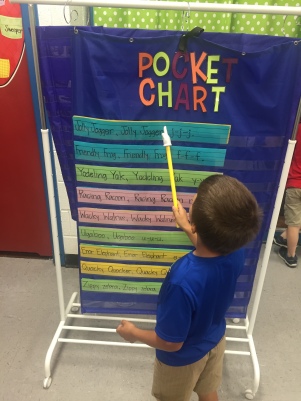In my previous post, I talked about how my first grade students are struggling to grasp phonic skills. By looking at my class data, I learned that I needed to review all of the sounds that students should have learned in Kindergarten. I chose to review these phonic skills by associating the letter with a sound and some thing the student could remember. Many years ago, I taught Kindergarten and my team introduced phonics by using rhymes for each letter. I chose to use my materials from my Kindergarten days and use the same chants.
Many phonic programs use a variety of approaches to teach concepts so that students capture the message that is being taught. Since my county does not require teachers to implement a particular method, I am not “licensed” to use certain program materials. Not having a mandated phonics program or access to any phonic materials has been extremely difficult, especially in a grade where learning phonic skills are essential. With this being said, I do not know the specific name of the program that uses the chants mentioned below.

.:Wally Walrus, Ellie Elephant, U-ga-boo, Goofy Ghost, Racing Raccoon, Curly Caterpillar, Vamp Vampire:.
This is an example of Jolly Phonics version of a chant/song:
Every day for the past 2 weeks, I have introduced 2-3 different phonic sounds to my students during our Morning Message. Students are shown the “puppet” of the sound that we are going over and say the chant 2 times. Then as a class, we construct a circle map of that sound and all of the words that we know that begin with that sound. These maps are placed around the classroom for students to use as a reference.
I also place the chants in my pocket chart literacy station. When students visit this station, they are required to use the pointer and say each chant. Then, students are to place picture cards with its associated sound. Students seem to enjoy this literacy station and have been successful with the placement of picture cards. My theory is that by having the chants available and requiring students to repeat them over and over, students are able to match the picture to its correct sound because they have made previous associations with the letter and the sound.

During guided reading, I have noticed students are using these phonic chants. When working with students in small groups, some students who come to an unfamiliar word use the chants to remember what the letter “says”. I see them saying the chants to themselves: “Ellie Elephant, Ellie Elephant, /e/, /e/, /e/”. This is meaningful to me because it shows that students are using the strategies that I have taught them.
Next week, I am going to implement live spelling, a technique in which you give students a “sound” and ask them to spell words. For example, during our Morning Message, I will pass out the “sounds” and say spell the word cat. I would then wait for the students with the correct sounds to stand up and arrange themselves in the correct order. I am interested to see how well my students grasp this engaging activity!
Meredith, I like to hear about the beginning phonics lessons you are doing in your first grade class! I only have experience in the upper elementary grades, so this is all so foreign to me. It sounds like you are incorporating some really interactive practice to help students learn and remember the sounds and patterns in words. I’d love to see this in action!
LikeLike